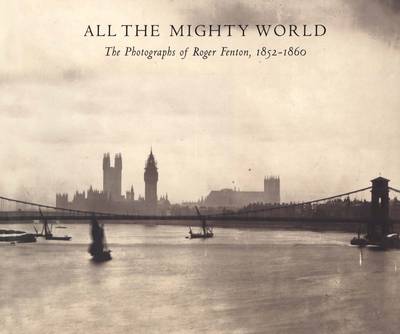Roger Fenton (1819-1869) was England's most celebrated photographer during the 1850s, the young medium's most glorious moment. After studying law and painting, Fenton took up the camera in 1851 and immediately began to produce highly original images. During a decade of work he mastered every photographic genre he attempted: architectural photography, landscape, portraiture, still life, reportage, and tableau vivant.
Fenton pictured noble country houses, evocative ruins, and the rolling countryside that surrounded them-majestic summations of rural England. Equally arresting are his muscular views of cathedrals and of the royal castles and Houses of Parliament that embodied Britain's power. Possessing flawless technique and an artist's instinct for composition and light, he made photographs that combine the clarity of a newly modern world with the poetry of a Romantic sensibility. Fenton's most compelling landscape works-intense meditations infused with a reverence for nature-call to mind cloud studies by Constable or Turner's explorations of light and atmosphere.
Fenton's grasp was wide-ranging. He traveled to Russia in 1852 and was among the first to photograph the Kremlin and other landmarks of Moscow and Kiev. Commissioned in 1855 to document the Crimean War-which pitted European nations against an expansionist Russia-he returned with portraits of shell-shocked soldiers and confident officers, views of a chaotic Balaklava harbor, and bleak panoramas of the terrain of battle.
Sharing the mid-nineteenth-century passion for all things exotic, Fenton produced a series of posed Orientalist costume pictures in which he strove for the theatrical effects of Delacroix and Ingres. A final, remarkable series of lush still lifes triumphantly achieves the same goal that Fenton had sought from the beginning: to demonstrate that photography could equal painting and even surpass it.
An active proponent of photography, Fenton was the force behind the founding of the Photographic Society (later the Royal Photographic Society), which encouraged the advancement of the medium and the exhibition of members' works throughout Britain. But in 1862, for reasons both personal and professional, he sold his equipment and negatives, resigned from society, and returned to the practice of law. In a career of a single decade, Fenton had done much to transform photography into a medium of powerful expression and visual delight.
This volume presents ninety of Fenton's finest photographs, exactingly reproduced. Six leading scholars have contributed nine illustrated essays that address every aspect of Fenton's career, as well as a comprehensive, documented chronology. [This book was originally published in 2004 and has gone out of print. This edition is a print-on-demand version of the original book.]
- ISBN10 030019949X
- ISBN13 9780300199499
- Publish Date 25 June 2013 (first published 11 October 2004)
- Publish Status Cancelled
- Publish Country US
- Imprint Metropolitan Museum of Art
- Format Paperback (US Trade)
- Pages 304
- Language English
